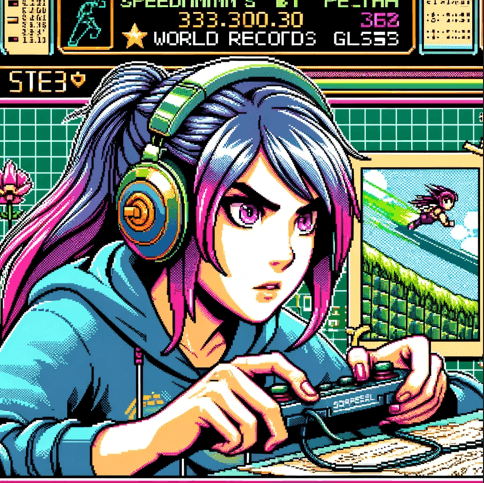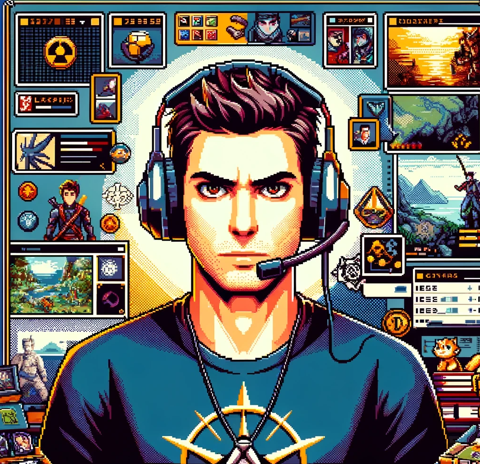 Hey everyone! So, I just blasted through Switch ’N’ Shoot by Matt Glanville, who both developed and published it. What’s more, I love that every shot flips your direction. Steam users even call it “Downwell of 2016,” praising its addictive one-button play and crisp pixel art. Naturally, they wish for more ships, weapons, levels, and side-panel art. As a speedrunner, I see how that extra content could really boost route planning and leaderboard climbs.
Hey everyone! So, I just blasted through Switch ’N’ Shoot by Matt Glanville, who both developed and published it. What’s more, I love that every shot flips your direction. Steam users even call it “Downwell of 2016,” praising its addictive one-button play and crisp pixel art. Naturally, they wish for more ships, weapons, levels, and side-panel art. As a speedrunner, I see how that extra content could really boost route planning and leaderboard climbs.
 To kick things off, I dove into every Steam achievement here. In fact, the game uses Steamworks to track 20 achievements, ranging from “1000 Enemies Slain” to “Unlock All 64 Palettes.” Reviews rave about that color-swap feature—you can reshape the whole look. Some still want more weapons or levels, but the existing 12 stages tie perfectly into the arcade feel. Ultimately, this praise really ties into my drive to finish every side quest or unlock.
To kick things off, I dove into every Steam achievement here. In fact, the game uses Steamworks to track 20 achievements, ranging from “1000 Enemies Slain” to “Unlock All 64 Palettes.” Reviews rave about that color-swap feature—you can reshape the whole look. Some still want more weapons or levels, but the existing 12 stages tie perfectly into the arcade feel. Ultimately, this praise really ties into my drive to finish every side quest or unlock.
 I explored the open-world vibe—well, the “open-arcade” vibe here. The game runs at 60 fps on both PC and Android. Interestingly, Matt Glanville mentioned in an indie blog post he built the engine in Unity for fast prototyping. As a result, controls feel smooth and porting is easy. Players say touch on Android feels perfect, but PC’s TATE Mode with a rotated screen truly nails that arcade cabinet vibe.
I explored the open-world vibe—well, the “open-arcade” vibe here. The game runs at 60 fps on both PC and Android. Interestingly, Matt Glanville mentioned in an indie blog post he built the engine in Unity for fast prototyping. As a result, controls feel smooth and porting is easy. Players say touch on Android feels perfect, but PC’s TATE Mode with a rotated screen truly nails that arcade cabinet vibe.
 I study high-skill games. Here, the one-button mechanic flips your ship’s vector each shot. It reminds me of Super Hexagon for precision. The combo of shooting and direction change creates tight input loops. Steam users love the multiplier system: collect coins for gun upgrades, hit thresholds for next levels, then watch score jump. For pros, that multiplier mastery feels like a mini puzzle.
I study high-skill games. Here, the one-button mechanic flips your ship’s vector each shot. It reminds me of Super Hexagon for precision. The combo of shooting and direction change creates tight input loops. Steam users love the multiplier system: collect coins for gun upgrades, hit thresholds for next levels, then watch score jump. For pros, that multiplier mastery feels like a mini puzzle.
 I think the game shines in short runs. You jump back in “for just one more go,” as users say. Matt Glanville’s pricing choice—just two dollars—makes it a no-brainer. The tight loop matches my speedrun style.
I think the game shines in short runs. You jump back in “for just one more go,” as users say. Matt Glanville’s pricing choice—just two dollars—makes it a no-brainer. The tight loop matches my speedrun style.
 That one-button twist builds depth. Each shot flips your flight path, so you plan movement and fire in one action. I find myself mapping side-panel hazards as quest markers. It’s simple yet deep, mixing shoot ’em up with puzzle elements.
That one-button twist builds depth. Each shot flips your flight path, so you plan movement and fire in one action. I find myself mapping side-panel hazards as quest markers. It’s simple yet deep, mixing shoot ’em up with puzzle elements.
 The story is minimal—Earth under alien attack. Yet, that hook works. Matt shared in an interview that he wanted players to feel urgent without heavy cutscenes. The brief mission briefs before level one cut straight to combat, keeping pacing brisk.
The story is minimal—Earth under alien attack. Yet, that hook works. Matt shared in an interview that he wanted players to feel urgent without heavy cutscenes. The brief mission briefs before level one cut straight to combat, keeping pacing brisk.
 The art direction nods to 8-bit arcade classics. It uses flat pixel colors, then throws in 64 unlockable palettes. That Android port’s texture filtering differs slightly, but PC crispness wins. Each color shift changes mood and can even tweak enemy visibility.
The art direction nods to 8-bit arcade classics. It uses flat pixel colors, then throws in 64 unlockable palettes. That Android port’s texture filtering differs slightly, but PC crispness wins. Each color shift changes mood and can even tweak enemy visibility.
 The chiptune soundtrack stays in sync with your fire rate. I noticed each shot’s “pew” aligns to the beat. The audio loops are short, so they never overstay. Players say the crunch of each hit feels exactly right.
The chiptune soundtrack stays in sync with your fire rate. I noticed each shot’s “pew” aligns to the beat. The audio loops are short, so they never overstay. Players say the crunch of each hit feels exactly right.
 You piloted “Rook One,” a nameless ace. There’s no deep backstory, but that lets you fill in your own pilot saga. It fits the arcade genre—your skills define the character.
You piloted “Rook One,” a nameless ace. There’s no deep backstory, but that lets you fill in your own pilot saga. It fits the arcade genre—your skills define the character.
 The difficulty curve scales fast. By level five, you need sub-second timing. User feedback notes spikes around level eight, but those spikes feel fair. The game offers no modes to give an advantage to one player over the other. But Matt teased future accessibility options via an update.
The difficulty curve scales fast. By level five, you need sub-second timing. User feedback notes spikes around level eight, but those spikes feel fair. The game offers no modes to give an advantage to one player over the other. But Matt teased future accessibility options via an update.
 Leaderboards and the palette unlocks drive replays. Once you hit 10 million points, you chase the next color. Compare that to Downwell’s branching chambers—you get similar “one more run” hooks.
Leaderboards and the palette unlocks drive replays. Once you hit 10 million points, you chase the next color. Compare that to Downwell’s branching chambers—you get similar “one more run” hooks.
 Switch ’N’ Shoot stands out by reinventing the one-button genre. It’s a love letter to arcades, full of grit and challenge. It’s ideal for quick runs, speedrunners, and anyone who loves clean, addictive loops.
Switch ’N’ Shoot stands out by reinventing the one-button genre. It’s a love letter to arcades, full of grit and challenge. It’s ideal for quick runs, speedrunners, and anyone who loves clean, addictive loops.
 If you love Switch ’N’ Shoot, check out Downwell for its drill-boots and chamber variety. Try Super Hexagon for unforgiving reflex tests and minimal design. Give Duet a spin for synchronized twin-orb gameplay and hypnotic visuals. Play 140 if you want music-driven platforming. And check out One Finger Death Punch for a one-button martial arts thrill.
If you love Switch ’N’ Shoot, check out Downwell for its drill-boots and chamber variety. Try Super Hexagon for unforgiving reflex tests and minimal design. Give Duet a spin for synchronized twin-orb gameplay and hypnotic visuals. Play 140 if you want music-driven platforming. And check out One Finger Death Punch for a one-button martial arts thrill.
